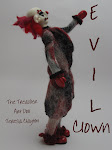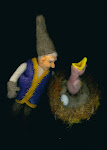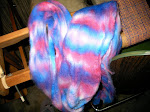*
Now, the princess was a textile and fiber artist / knitting and weaving addict and so naturally she immediately thought, "Oh Yes! This will do nicely as part of my next project!"*
The eggs are hatching. I had to hurry up and try to mix their mulberry chow!It does look scrumptious but, is "not for human consumption" so we'll never know. As I added the hot water and began to stir the chow I noticed the kitchen smelled a bit like mown lawn. I opted to follow the microwave cooking directions as I must have misplaced my double boiler needed for the stove top preparation. After a good 5 min. nuke and a little stirring we had hot food. Shortly there after we had room temperature food and I dished some up for the little characters.
Look closely. Here are the tiny silkworms picnicing on a big green scoop of delicious mulberry chow.
The worms are about the width of a pencil line
I've counted approx 75 tiny silkworms so far. In the morning I'll have a pretty good idea about how many of the 500 eggs will hatch. I'm getting thermometer readings of a steady 84 deg. F. Maintaining a temperature of 78 to 88 deg. F. is said to be most important, especially during this first week or so. It is also important that the petri dish remain covered to keep the food moist and yet, the attentive insect owner must be watchful for moisture or condensation build-up as even the tiniest of water droplets could form within the dish and drown the little tikes. There may be some pensive, pacing up and down the corridors as we make our way through this initial 72 hours. As I've never gotten to have that herd of sheep I've always wanted I'm pretending that this is my flock and it is lambing season.
*
Claxton has been busy boiling water. (We don't need any.) My job is to gently lift each new worm with a small, soft paint brush away from the hatching area over to the feeding area. Even as tiny as they are these little silkworms are already creating nearly invisible silken fibers. They hang from them off the tip of my paint brush as I individually lift them away from the eggs. If they are left to crawl over the eggs they will drop silk making it difficult for the others to hatch forth.


























No comments:
Post a Comment